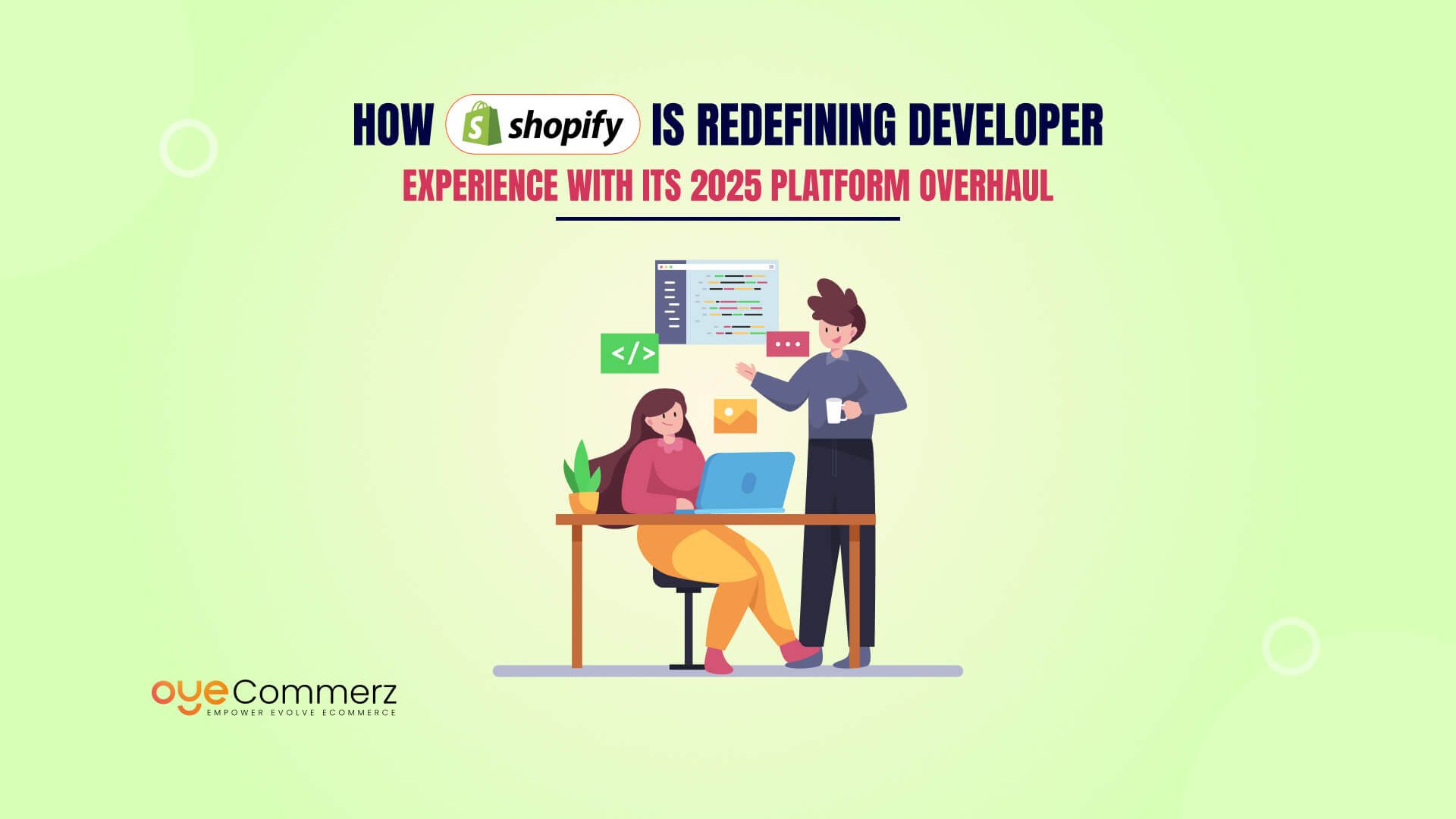Do you know? In 2025, standalone landing pages are facing a significant decline in effectiveness. According to a study by Unbounce, the average conversion rate for landing pages is 4.02%, highlighting the need for more dynamic solutions. This decline is largely due to static designs, slow load times, and a lack of personalization, which no longer meet the expectations of today’s consumers.
Enter Shopify’s AI layout tools, such as the AI Store Builder and Shopify Magic, which are revolutionizing the ecommerce landscape. These tools enable merchants to create fully functional online stores using descriptive keywords, streamlining the setup process and enhancing user experience. By automating design and layout decisions, Shopify’s services are setting a new standard for ecommerce platforms.
In this blog, we’ll explore whether standalone landing pages are becoming obsolete and how Shopify’s AI-driven solutions are leading this transformation.
The Evolution of Standalone Landing Pages in Ecommerce
Standalone landing pages have long been a cornerstone of digital marketing strategies, particularly in ecommerce. Initially, these pages served as targeted destinations for users clicking on advertisements, emails, or search engine results. Their primary objectives included-
- Lead Generation: Capturing user information through forms to build customer databases.
- Product Highlighting: Showcasing specific products or offers to drive sales.
- Pay-Per-Click (PPC) Focus: Maximizing the effectiveness of paid advertising campaigns by directing traffic to relevant content.
In the early 2000s, the use of standalone landing pages surged as businesses recognized their potential to increase conversion rates. However, as consumer behavior evolved, the limitations of static landing pages became apparent. Users began to expect more personalized and dynamic experiences, leading to a decline in the effectiveness of traditional landing pages.
According to data from Statista, the average conversion rate for ecommerce websites has seen fluctuations over the years. In 2020, the global ecommerce conversion rate was approximately 2.17%, and by 2023, it had slightly decreased to around 2.01%. This decline underscores the need for more adaptive and personalized marketing approaches.
The static nature of standalone landing pages often results in a one-size-fits-all experience, which may not resonate with diverse customer segments. Additionally, the lack of real-time adaptability can lead to missed opportunities in engaging users effectively.
In response to these challenges, ecommerce platforms like Shopify have introduced AI-driven layout tools that enable dynamic content personalization and real-time user engagement. These innovations aim to address the shortcomings of traditional landing pages by offering more tailored and responsive user experiences.
Why Traditional Landing Pages Are Losing Relevance Today
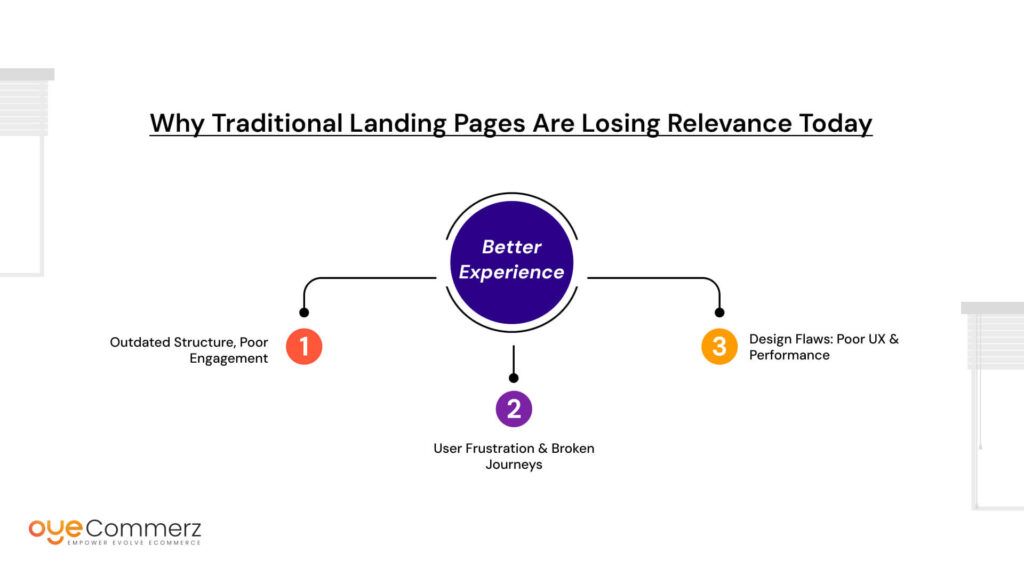
Traditional standalone landing pages once helped marketers drive quick wins in customer acquisition. But today, these static pages are rapidly falling behind due to evolving user expectations and technology standards.
Outdated Structure, Poor Engagement
- Low Conversion Rates: As reported by Statista, the average ecommerce conversion rate has slipped below 2.01% in 2024, showing a consistent decline over five years.
- Slow Loading Speeds: Pages with large, static images and cluttered designs often take too long to load, leading to frustration.
- Generic Experience: Static landing pages typically offer a one-size-fits-all design, which feels impersonal in a world of dynamic content.
User Frustration & Broken Journeys
- Higher Bounce Rates: When a landing page takes longer than 3 seconds to load, over 53% of mobile users abandon it.
- Mobile Unfriendliness: Many traditional landing pages are not optimized for mobile, causing fragmented navigation and text overlap.
- Misaligned Buyer Intent: Users coming from PPC campaigns often find generic content that doesn’t match their search or ad click.
Design Flaws: Poor UX & Performance
- Cluttered CTAs: Too many calls-to-action confuse rather than convert. A focused layout is essential, but many landing pages still try to do too much.
- Static Templates: Old-fashioned templates lack flexibility to adapt content based on behavior, region, or device.
What Users Want Now
Today’s users expect:
- Fast-loading interfaces
- Personalized journeys
- Seamless mobile experience
- Intent-matching content
When traditional landing pages fail to deliver, users click away. The gap between static experiences and modern user expectations is exactly what AI-powered layout tools, like those from Shopify, are designed to bridge.
The Rise of Shopify AI Layout Tools in E-commerce Design
Shopify’s AI layout tools are changing the way ecommerce stores are built, offering dynamic and automated solutions that go far beyond traditional design practices. These tools are no longer just add-ons, they’re becoming core components of modern ecommerce architecture.
Shopify’s suite of AI layout features is designed to streamline store creation by using natural language inputs, allowing merchants to describe the type of store they want. From there, AI builds complete storefronts with fully responsive designs. This marks a dramatic shift from manual drag-and-drop builders to intelligent layout generation based on predicted user behavior and design best practices.
How Shopify AI Layout Tools Redefine UX
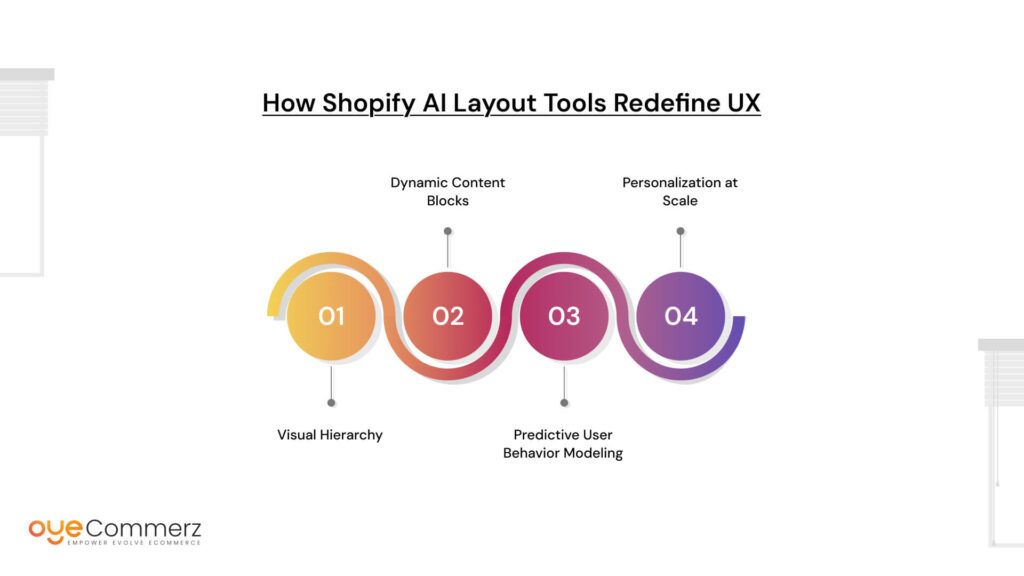
Here’s how Shopify’s AI-driven tools are reshaping user experience:
- Visual Hierarchy: Shopify’s layouts automatically prioritize elements such as CTAs, product visuals, and trust signals. This ensures users see the most important information first, without overwhelming them with clutter.
- Dynamic Content Blocks: Rather than using static content sections, the AI engine places content dynamically. It adjusts placement depending on expected engagement patterns and device types, offering a more fluid and user-specific browsing experience.
- Predictive User Behavior Modeling: Using machine learning, Shopify’s AI analyzes past user actions to predict what layout components will drive engagement and conversions. This leads to a more intuitive and effective shopping journey.
- Personalization at Scale: Shopify’s AI layout tools personalize content presentation based on visitor demographics, device type, and browsing history, without requiring manual configuration by store owners.
A Nod to Shopify Editions 2024
With the release of Shopify Editions 2024, these AI layout capabilities have seen a major leap forward. Merchants can now access features like keyword-to-layout translation and smart visual generation tools, which accelerate the time from store concept to launch. This reflects a broader industry trend toward automating not just backend operations but also the customer-facing experience.
Built-In Intelligence for Seamless Design
Shopify’s layout tools don’t just automate, they enhance. Predictive AI models decide optimal spacing, image size, and even font treatments based on expected scroll depth and click-through behavior. It’s like having a UX designer embedded into the platform.
As ecommerce grows more competitive, this kind of intelligent automation gives businesses a real edge.
Now that we’ve explored how Shopify AI layout tools are shaping the future, let’s see how they stack up directly against standalone landing pages.
AI-Driven Design vs Standalone Landing Pages: A Functional Comparison
As ecommerce evolves, the tools we use to build online experiences must also grow smarter. Traditional standalone landing pages were once the go-to solution for marketers to drive traffic and conversions. But with the rise of AI in platforms like Shopify, the gap between manual design and intelligent automation has widened.
Shopify’s AI layout tools are designed to reduce guesswork and deliver results faster. From customizing page layouts to optimizing user paths, AI takes care of the technicalities so merchants can focus on their business.
Here’s a simple comparison of key features between traditional standalone landing pages and Shopify’s AI-driven layout tools:
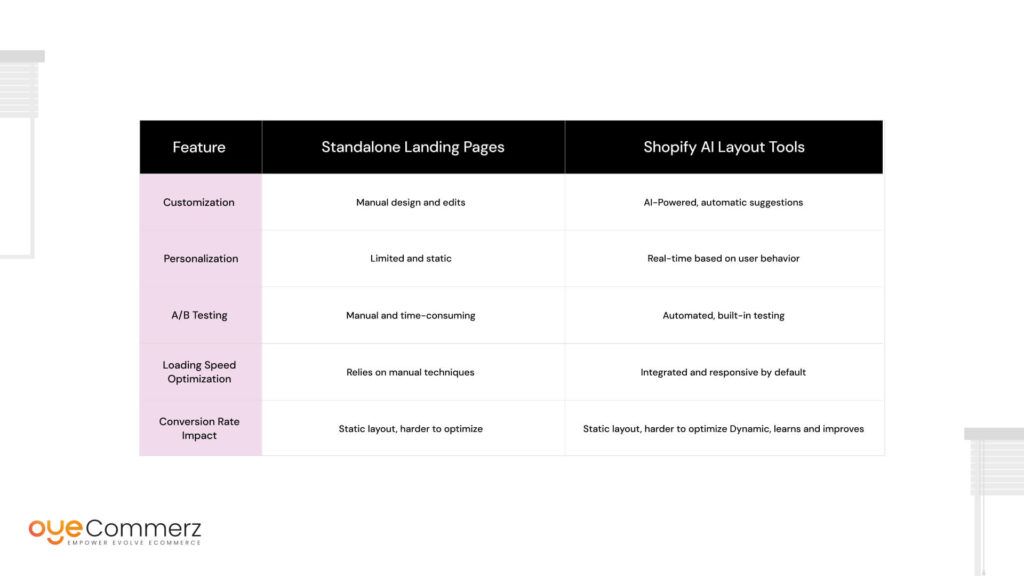
With traditional landing pages, every improvement, like testing a CTA button or changing an image, requires time, effort, and often, development support. In contrast, Shopify’s AI layouts adapt in real time based on user interactions and performance data.
This intelligent structure not only saves time but also improves how customers experience the store. When elements load faster, feel more relevant, and guide users naturally, conversions go up.
Now let’s explore what this means for your bottom line and whether it’s time to transition fully from static landing pages to smarter, AI-powered ecommerce design.
How Shopify AI Layout Tools Optimize Ecommerce Conversions
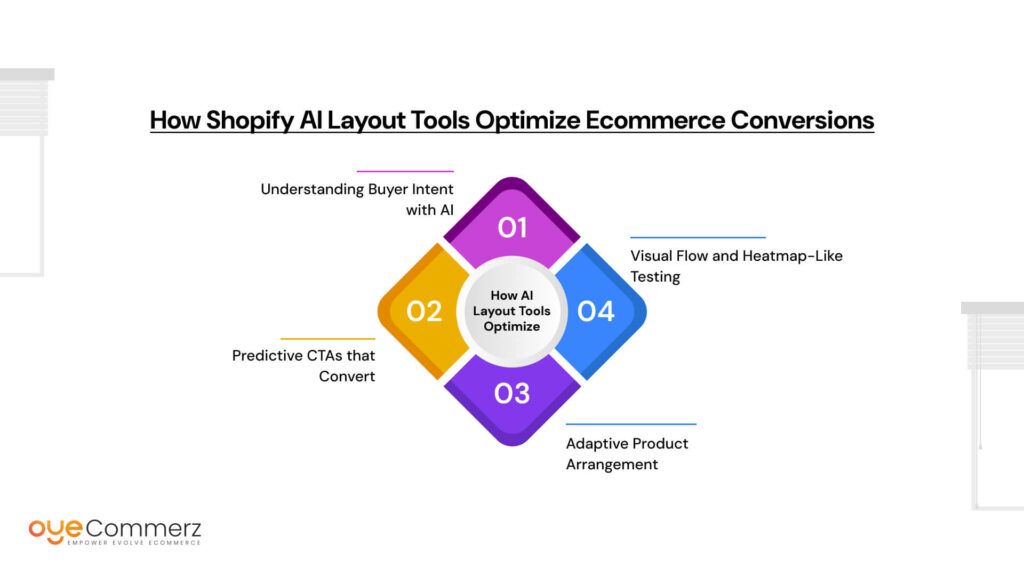
Shopify AI layout tools are built to do more than just design good-looking pages, they are engineered to boost ecommerce conversions. The system works by mapping layout decisions directly with buyer intent, helping users move from browsing to buying with less friction.
Understanding Buyer Intent with AI
Shopify’s AI studies user behavior patterns, like scrolling, clicks, and time spent on specific elements, to predict what buyers are looking for. Based on this, it automatically adjusts:
- The layout flow
- Product visibility
- Button placement
- Content hierarchy
This level of intelligence turns a basic store into a responsive sales machine.
Predictive CTAs that Convert
One of the most powerful features is predictive CTA placement. Instead of static buttons placed at random spots, Shopify’s AI analyzes user journeys and adds CTAs where users are most likely to take action. This can mean placing “Buy Now” buttons near scroll-stopping visuals or using a sticky bar for mobile users.
Adaptive Product Arrangement
Shopify’s layout tools also adapt how products are displayed based on:
- User browsing history
- Device type
- Time on page
For example, if a returning customer is browsing a product category, AI can prioritize bestsellers or items they viewed previously. This increases the chance of re-engagement and final purchase.
Visual Flow and Heatmap-Like Testing
Shopify uses AI-powered systems that mimic heatmap testing, analyzing where users look, click, and drop off. It then fine-tunes:
- Image sizing
- Font choices
- Spacing
- Button colors
All of this creates a visual flow that guides the buyer’s eye toward completing a purchase.
Many successful Shopify stores now use these AI tools to improve performance. Without mentioning brands, these stores report better user journeys, higher cart values, and reduced bounce rates, all thanks to smart layout decisions made in real time.
Shopify’s AI doesn’t just design, it continuously learns and improves layout strategies to match customer behavior.
Next, let’s explore whether standalone landing pages still have any place in this new ecommerce landscape.
Landing Page Optimization Reimagined: AI Leads the Way
For years, marketers relied on traditional landing page optimization tools like heatmaps, manual A/B testing, and static performance data. These methods helped shape the digital marketing world, but they’ve reached their limits in a fast-moving ecommerce environment.
The Problem with Traditional Optimization
Old-school techniques like manual A/B testing require time, resources, and constant analysis. You had to test two or more page variants, wait days or weeks for traffic, then manually interpret the results. Heatmaps, while helpful, only told part of the story and often missed mobile behavior completely.
- Time-consuming processes
- Human bias in layout decisions
- Lack of agility when consumer trends shift
- Delayed response to buyer behavior
The result? Businesses spent more time testing than converting. Opportunities were lost due to slow reaction times and outdated design elements.
The Solution: AI-Based Design with Shopify
Shopify has changed the game with AI-driven design. Instead of making guesses or waiting for tests to finish, the platform’s intelligent layout tools make real-time decisions for every visitor.
Here’s how Shopify’s AI helps:
- Eliminates guesswork: No more guessing which layout works best. AI uses data to decide.
- Real-time testing: Shopify AI analyzes visitor behavior on the fly and tests layout variations instantly.
- Auto-adjustments: Layouts shift and adapt in milliseconds based on what works best.
Dynamic Modules Adapt to User Behavior
Shopify’s layouts are built using dynamic modules, smart content blocks that adjust based on how a user interacts with a page. These modules can rearrange:
- Product displays
- Reviews
- CTA buttons
- Offers and banners
For example, if a user hovers on a product but doesn’t click, the AI might enlarge the product image or bring in social proof nearby. These changes happen instantly, helping convert visitors who might otherwise bounce.
Continuous Improvement Without the Wait
The biggest advantage? Constant learning. Shopify’s AI layout tools don’t need marketers to stop and analyze, they learn and update continuously, keeping your ecommerce experience fresh, relevant, and optimized.
In today’s ecommerce space, static landing page testing simply can’t compete. AI delivers faster insights, smarter design choices, and better conversions.
Let’s now look at whether standalone landing pages still have any edge, or if they’re officially outdated.
Impacts on Funnel Strategies and Customer Journeys
Today’s ecommerce sales funnels require flexibility, adaptability, and responsiveness. Rigid structures no longer serve the dynamic behaviors of online shoppers. Traditional standalone landing pages, once considered powerful, now often limit the potential of modern multichannel sales flows.
The Limitation of Standalone Landing Pages
Standalone landing pages are built with one goal and one user segment in mind. They often support single campaigns, ideal for product launches or PPC ads, but fall short when shoppers enter from multiple channels with varied intent. These static pages:
- Fail to adjust based on traffic source
- Cannot serve personalized product combinations
- Struggle to guide customers across complex journeys
The result? Lost engagement and disconnected funnel experiences that reduce conversions and lifetime value.
Shopify AI Layout Tools Enable Funnel Fluidity
Shopify’s AI layout tools remove these restrictions. Instead of locking users into a fixed journey, AI adapts the page layout based on the visitor’s behavior, device, and purchase history. This allows seamless integration across multiple stages of the sales funnel.
Shopify AI supports:
- Multi-product targeting: Visitors see tailored product collections based on past interactions.
- Cross-selling and upselling: Smart layout blocks suggest relevant add-ons at the perfect time.
- Personalized journeys: Layouts change in real time to align with where users are in the buying cycle.
Whether a visitor arrives from Instagram, email, or organic search, the page they land on adapts, ensuring relevance and increasing the chance of conversion.
Adaptive Funnels That Convert
By linking funnel strategy directly with user data, Shopify’s tools create personalized experiences at scale. This reduces drop-offs, supports multichannel engagement, and guides users toward the next step with minimal friction.
In a world where personalization defines performance, flexible funnel design is no longer optional, it’s essential.
Will Standalone Landing Pages Survive in 2025 and Beyond?
As ecommerce evolves, the role of standalone landing pages is rapidly diminishing. Modern customer expectations, paired with technological advancements, are reshaping how brands design digital experiences. One of the key drivers of this shift is the adoption of AI layout tools, particularly those integrated within platforms like Shopify.
The Rise of AI Layout Tools
AI-powered layout tools are no longer niche innovations. They’re becoming standard features in ecommerce platforms, thanks to their ability to:
- Personalize content in real time
- Optimize user journeys automatically
- Adjust layouts based on device and behavior
This level of intelligence far surpasses the fixed nature of traditional standalone landing pages. Instead of a one-size-fits-all experience, AI offers contextual relevance and continuous improvement.
Ecommerce Platforms Are Moving On
Platforms such as Shopify are steadily moving away from rigid, single-page structures. Instead, they favor modular, dynamic layouts that adapt and scale. These tools allow merchants to respond instantly to user signals, streamline multi-touch journeys, and improve conversion paths across devices and channels.
AI in Omnichannel Strategy
AI doesn’t just enhance single interactions, it powers entire omnichannel strategies. From social commerce to email marketing to in-app browsing, AI tailors experiences across each touchpoint. This interconnected system is the future of ecommerce, and standalone landing pages simply weren’t built for this level of integration.
The Forecast: AI is the Future
By 2025, it’s expected that over 70% of ecommerce websites will integrate AI-assisted design tools. With such widespread adoption, static standalone pages will struggle to remain relevant.
While they may still have niche uses, their dominance is over. AI is now leading the way in building smarter, faster, and more effective ecommerce experiences.
Practical Tips: Transitioning from Static Pages to AI-Based Layouts
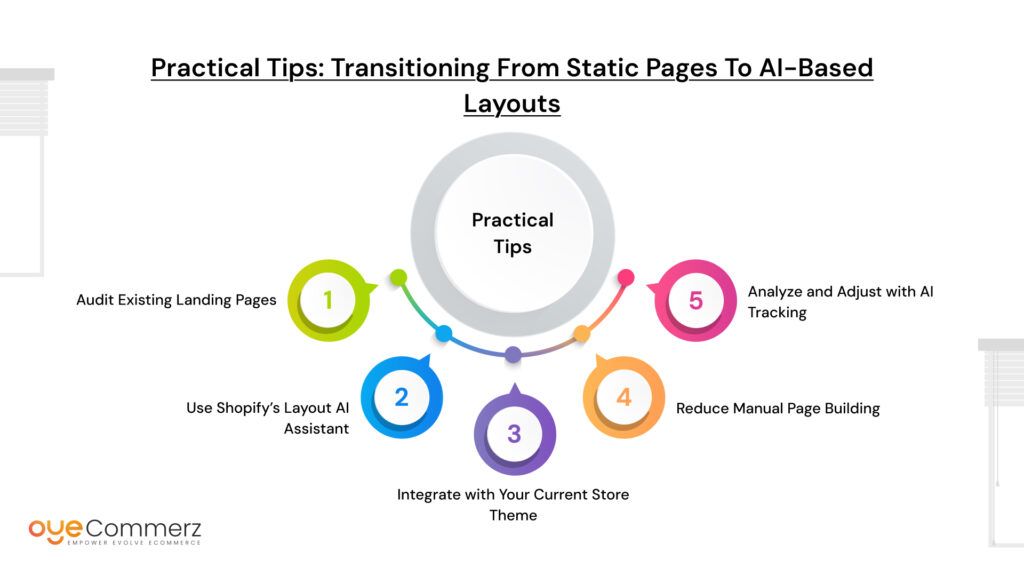
Moving from traditional static landing pages to intelligent, AI-driven layouts can seem complex, but it doesn’t have to be. With the right approach, ecommerce brands can make the transition smoothly and start reaping the benefits of personalization, speed, and automation.
1. Audit Existing Landing Pages
Start with a clear analysis. Identify which landing pages have low engagement, high bounce rates, or poor mobile performance. Focus on pages with outdated designs, generic CTAs, and rigid structure. This audit will help prioritize where AI integration will have the most immediate impact.
2. Use Shopify’s Layout AI Assistant
Shopify’s built-in AI layout assistant can generate optimized page structures based on your store’s data. Whether you’re highlighting a product collection, running a promotion, or telling your brand story, the assistant provides dynamic templates tailored to user behavior.
3. Integrate with Your Current Store Theme
No need to rebuild everything from scratch. Shopify’s AI tools are designed to work with existing themes. They embed into your current design system, maintaining visual consistency while enhancing layout performance. Use modular blocks for flexibility and test integration on key pages first.
4. Reduce Manual Page Building
Say goodbye to time-consuming drag-and-drop builders. With AI, layouts adapt in real time without requiring manual edits. Focus your resources on crafting great content and offers—let the layout take care of itself.
5. Analyze and Adjust with AI Tracking
Use Shopify’s AI tracking to monitor user interactions. The data reveals how visitors navigate your store, where they drop off, and what they click. Based on this insight, adjust content blocks, reposition CTAs, or re-sequence sections to better guide the customer journey.
Transition smart, optimize with AI
Debunking the Myth: AI Doesn’t Kill Creativity- It Fuels It
Myth: AI Kills Creativity
Many marketers believe that using AI tools means losing control over their brand’s unique voice and visual identity. They worry automation will lead to generic, cookie-cutter designs.
The Real Truth: AI Enhances Creativity
AI is not meant to replace creativity but to support and amplify it, acting as a creative co-pilot rather than a replacement.
AI Handles Repetitive Tasks
Shopify’s AI layout tools take care of time-consuming jobs like optimizing layouts, arranging modules, and testing calls-to-action, freeing marketers to focus on storytelling and branding.
Balance Between AI and Human Control
While AI manages the structure and performance aspects, marketers retain full control over visuals, copy, and branding through manual overrides.
AI Clears the Clutter
Instead of restricting creativity, AI removes routine tasks so your vision can shine through with less effort and faster execution.
Smarter, Faster, and More Beautiful Stores
With AI support, brands can deliver ecommerce experiences that are not only efficient but also more thoughtfully designed and emotionally engaging.
Creativity and AI Can Thrive Together
The right tools enable a seamless partnership between human creativity and AI-driven efficiency, unlocking new possibilities for ecommerce design.
Wondering how to move beyond outdated standalone landing pages?
Leverage the power of AI-driven design with OyeCommerz’s expert Shopify services.
We help you integrate cutting-edge Shopify AI layout tools to boost conversions and personalize user experiences effortlessly.
Take your ecommerce store to the next level!
Contact us today! and start transforming your digital presence!
Contact to Migrate your Site to Shopify Now
Conclusion
Ecommerce has evolved, and so have consumer expectations. The rigid structure of traditional standalone landing pages no longer aligns with how users browse, buy, and interact online. Static designs, limited personalization, and slow adaptation simply can’t compete in today’s fast-moving digital space.
Smart brands are moving away from outdated practices and embracing agile, AI-powered tools that optimize layouts in real time. Shopify AI layout tools lead this shift, offering dynamic user experiences, personalized product displays, and predictive CTAs that drive real results.
By leveraging Shopify services, businesses can seamlessly transition to a smarter layout strategy, one that adapts, performs, and scales effortlessly.
Now is the time to audit your current landing pages, identify friction points, and explore how Shopify’s AI toolkit can reshape your funnel. In ecommerce, staying still means falling behind. Evolve with the times, or risk losing the conversions you’ve worked hard to earn.
Frequently Asked Questions
A standalone landing page is a dedicated web page focused on a single goal, usually conversions, separate from your main site navigation.
Yes, landing pages are crucial for targeted campaigns, improving conversions, and tracking performance, especially with paid ads and promotions.
Use clear CTAs, fast loading speeds, mobile-friendly design, trust signals (like reviews), and align content with your ad or campaign intent.
PageFly, Shogun, and GemPages are top-rated builders, but Shopify’s AI layout tools in 2025 offer intelligent, in-platform alternatives for smarter design.
Strong headlines, persuasive copy, visual consistency, responsive design, A/B testing, and data-driven layout decisions are key to high-performing pages.

